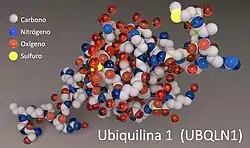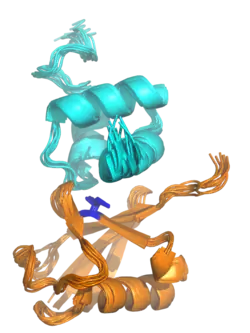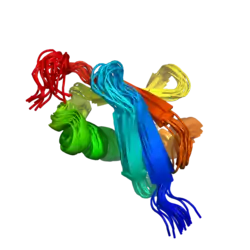UBQLN1
Ubiquilin-1 is a protein that in humans is encoded by the UBQLN1 gene.[5][6][7]
Ubiquilins contain two domains, an N-terminal ubiquitin-like domain and a C-terminal ubiquitin-associated domain. They physically associate with both proteasomes and ubiquitin ligases, and thus are thought to functionally link the ubiquitination machinery to the proteasome to effect in vivo protein degradation.
Functions
Ubiquilin-1 is associated with protein degradation and aggregation of misfolded proteins, and may be involved in neurodegenerative diseases.[8][9] Ubiquilin-1 has been reported to act as a molecular chaperone for amyloid precursor protein (APP), a protein associated with Alzheimer's disease.[10]
Ubiquilin-1 was first identified through its interactions with presenilins.[11] Two transcript variants encoding different isoforms have been found for this gene.[7]
Related proteins
Human UBQLN1 shares a high degree of similarity with related ubiquilins including UBQLN2 and UBQLN4.[12]
Interactions
UBQLN1 has been shown to interact with
References
- GRCh38: Ensembl release 89: ENSG00000135018 - Ensembl, May 2017
- GRCm38: Ensembl release 89: ENSMUSG00000005312 - Ensembl, May 2017
- "Human PubMed Reference:". National Center for Biotechnology Information, U.S. National Library of Medicine.
- "Mouse PubMed Reference:". National Center for Biotechnology Information, U.S. National Library of Medicine.
- Ozaki T, Hishiki T, Toyama Y, Yuasa S, Nakagawara A, Sakiyama S (August 1997). "Identification of a new cellular protein that can interact specifically with DAN". DNA and Cell Biology. 16 (8): 985–91. doi:10.1089/dna.1997.16.985. PMID 9303440.
- Hanaoka E, Ozaki T, Ohira M, Nakamura Y, Suzuki M, Takahashi E, et al. (Jul 2000). "Molecular cloning and expression analysis of the human DA41 gene and its mapping to chromosome 9q21.2-q21.3". Journal of Human Genetics. 45 (3): 188–91. doi:10.1007/s100380050209. PMID 10807547.
- "Entrez Gene: UBQLN1 ubiquilin 1".
- Haapasalo A, Viswanathan J, Bertram L, Soininen H, Tanzi RE, Hiltunen M (February 2010). "Emerging role of Alzheimer's disease-associated ubiquilin-1 in protein aggregation". Biochemical Society Transactions. 38 (Pt 1): 150–5. doi:10.1042/BST0380150. PMID 20074050.
- Zhang C, Saunders AJ (June 2009). "An emerging role for Ubiquilin 1 in regulating protein quality control system and in disease pathogenesis". Discovery Medicine. 8 (40): 18–22. PMID 19772837.
- Stieren ES, El Ayadi A, Xiao Y, Siller E, Landsverk ML, Oberhauser AF, et al. (October 2011). "Ubiquilin-1 is a molecular chaperone for the amyloid precursor protein". The Journal of Biological Chemistry. 286 (41): 35689–98. doi:10.1074/jbc.M111.243147. PMC 3195644. PMID 21852239. Lay summary – Science Daily.
- Mah AL, Perry G, Smith MA, Monteiro MJ (November 2000). "Identification of ubiquilin, a novel presenilin interactor that increases presenilin protein accumulation". The Journal of Cell Biology. 151 (4): 847–62. doi:10.1083/jcb.151.4.847. PMID 11076969.
- Marín I (March 2014). "The ubiquilin gene family: evolutionary patterns and functional insights". BMC Evolutionary Biology. 14: 63. doi:10.1186/1471-2148-14-63. PMC 4230246. PMID 24674348.
- Kim TY, Kim E, Yoon SK, Yoon JB (May 2008). "Herp enhances ER-associated protein degradation by recruiting ubiquilins". Biochemical and Biophysical Research Communications. 369 (2): 741–6. doi:10.1016/j.bbrc.2008.02.086. PMID 18307982.
- Wu S, Mikhailov A, Kallo-Hosein H, Hara K, Yonezawa K, Avruch J (January 2002). "Characterization of ubiquilin 1, an mTOR-interacting protein". Biochimica et Biophysica Acta. 1542 (1–3): 41–56. doi:10.1016/S0167-4889(01)00164-1. PMID 11853878.
- Ko HS, Uehara T, Nomura Y (September 2002). "Role of ubiquilin associated with protein-disulfide isomerase in the endoplasmic reticulum in stress-induced apoptotic cell death". The Journal of Biological Chemistry. 277 (38): 35386–92. doi:10.1074/jbc.M203412200. PMID 12095988.
- Mah AL, Perry G, Smith MA, Monteiro MJ (November 2000). "Identification of ubiquilin, a novel presenilin interactor that increases presenilin protein accumulation". The Journal of Cell Biology. 151 (4): 847–62. doi:10.1083/jcb.151.4.847. PMC 2169435. PMID 11076969.
- Kleijnen MF, Shih AH, Zhou P, Kumar S, Soccio RE, Kedersha NL, et al. (August 2000). "The hPLIC proteins may provide a link between the ubiquitination machinery and the proteasome". Molecular Cell. 6 (2): 409–19. doi:10.1016/S1097-2765(00)00040-X. PMID 10983987.
- Rolland T, Taşan M, Charloteaux B, Pevzner SJ, Zhong Q, Sahni N, et al. (November 2014). "A proteome-scale map of the human interactome network". Cell. 159 (5): 1212–1226. doi:10.1016/j.cell.2014.10.050. PMC 4266588. PMID 25416956.
Further reading
- Ozaki T, Kondo K, Nakamura Y, Ichimiya S, Nakagawara A, Sakiyama S (August 1997). "Interaction of DA41, a DAN-binding protein, with the epidermal growth factor-like protein, S(1-5)". Biochemical and Biophysical Research Communications. 237 (2): 245–50. doi:10.1006/bbrc.1997.7122. PMID 9268694.
- Ozaki T, Hanaoka E, Naka M, Nakagawara A, Sakiyama S (June 1999). "Cloning and characterization of rat BAT3 cDNA". DNA and Cell Biology. 18 (6): 503–12. doi:10.1089/104454999315222. PMID 10390159.
- Wu AL, Wang J, Zheleznyak A, Brown EJ (October 1999). "Ubiquitin-related proteins regulate interaction of vimentin intermediate filaments with the plasma membrane". Molecular Cell. 4 (4): 619–25. doi:10.1016/S1097-2765(00)80212-9. PMID 10549293.
- Kleijnen MF, Shih AH, Zhou P, Kumar S, Soccio RE, Kedersha NL, et al. (August 2000). "The hPLIC proteins may provide a link between the ubiquitination machinery and the proteasome". Molecular Cell. 6 (2): 409–19. doi:10.1016/S1097-2765(00)00040-X. PMID 10983987.
- Mah AL, Perry G, Smith MA, Monteiro MJ (November 2000). "Identification of ubiquilin, a novel presenilin interactor that increases presenilin protein accumulation". The Journal of Cell Biology. 151 (4): 847–62. doi:10.1083/jcb.151.4.847. PMC 2169435. PMID 11076969.
- Wiemann S, Weil B, Wellenreuther R, Gassenhuber J, Glassl S, Ansorge W, et al. (March 2001). "Toward a catalog of human genes and proteins: sequencing and analysis of 500 novel complete protein coding human cDNAs". Genome Research. 11 (3): 422–35. doi:10.1101/gr.GR1547R. PMC 311072. PMID 11230166.
- Simpson JC, Wellenreuther R, Poustka A, Pepperkok R, Wiemann S (September 2000). "Systematic subcellular localization of novel proteins identified by large-scale cDNA sequencing". EMBO Reports. 1 (3): 287–92. doi:10.1093/embo-reports/kvd058. PMC 1083732. PMID 11256614.
- Bedford FK, Kittler JT, Muller E, Thomas P, Uren JM, Merlo D, et al. (September 2001). "GABA(A) receptor cell surface number and subunit stability are regulated by the ubiquitin-like protein Plic-1". Nature Neuroscience. 4 (9): 908–16. doi:10.1038/nn0901-908. PMID 11528422. S2CID 13078743.
- Wu S, Mikhailov A, Kallo-Hosein H, Hara K, Yonezawa K, Avruch J (January 2002). "Characterization of ubiquilin 1, an mTOR-interacting protein". Biochimica et Biophysica Acta. 1542 (1–3): 41–56. doi:10.1016/S0167-4889(01)00164-1. PMID 11853878.
- Ko HS, Uehara T, Nomura Y (September 2002). "Role of ubiquilin associated with protein-disulfide isomerase in the endoplasmic reticulum in stress-induced apoptotic cell death". The Journal of Biological Chemistry. 277 (38): 35386–92. doi:10.1074/jbc.M203412200. PMID 12095988.
- Gao L, Tu H, Shi ST, Lee KJ, Asanaka M, Hwang SB, Lai MM (April 2003). "Interaction with a ubiquitin-like protein enhances the ubiquitination and degradation of hepatitis C virus RNA-dependent RNA polymerase". Journal of Virology. 77 (7): 4149–59. doi:10.1128/JVI.77.7.4149-4159.2003. PMC 150629. PMID 12634373.
- Massey LK, Mah AL, Ford DL, Miller J, Liang J, Doong H, Monteiro MJ (February 2004). "Overexpression of ubiquilin decreases ubiquitination and degradation of presenilin proteins". Journal of Alzheimer's Disease. 6 (1): 79–92. doi:10.3233/jad-2004-6109. PMID 15004330.
- Colland F, Jacq X, Trouplin V, Mougin C, Groizeleau C, Hamburger A, et al. (July 2004). "Functional proteomics mapping of a human signaling pathway". Genome Research. 14 (7): 1324–32. doi:10.1101/gr.2334104. PMC 442148. PMID 15231748.
- Persson P, Stockhausen MT, Påhlman S, Axelson H (November 2004). "Ubiquilin-1 is a novel HASH-1-complexing protein that regulates levels of neuronal bHLH transcription factors in human neuroblastoma cells". International Journal of Oncology. 25 (5): 1213–21. doi:10.3892/ijo.25.5.1213. PMID 15492808.
- Bertram L, Hiltunen M, Parkinson M, Ingelsson M, Lange C, Ramasamy K, et al. (March 2005). "Family-based association between Alzheimer's disease and variants in UBQLN1". The New England Journal of Medicine. 352 (9): 884–94. doi:10.1056/NEJMoa042765. PMID 15745979.






